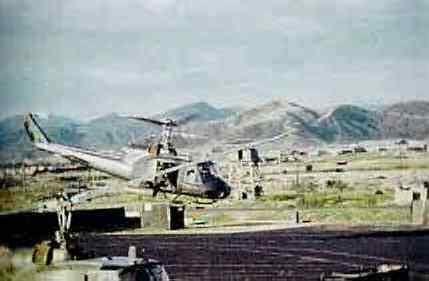

|
|
||||
Lynn Taylor, UFO Field Investigator
|
|
AH-1 HueyCobra* (See author's note below)
Armed helicopters came into widespread use in Vietnam in the early Sixties. Limitations of the modified armed utility helicopters used led to the specially configured attack helicopter. Bell Helicopter (now Bell Helicopter Textron) had already evolved the first attack helicopter design, based on the use of UH-1 Huey dynamics (rotors, drives, engine) with a new fuselage. Bell also built a company-sponsored, scaled-down prototype using H-13/Model 47 series components, its Model 207 Sioux Scout. While the Army went forward with its sophisticated AAFSS (advanced aerial fire support system) program to provide an attack helicopter, Bell proceeded with another company-sponsored prototype, Model 209, using the Huey dynamics and an airframe similar to the initial design. The 209 first flew in September 1965. The urgent need for greater armed helicopter performance in Vietnam and the success of the 209 led to Army orders for prototypes and production models of the 209 as interim attack helicopters, pending production of the AAFSS (which, finally, was never to occur). Carried over from the 209 were the slim fuselage with tandem cockpits (gunner in front of pilot), the Lycoming T-53 engine, stub wings with store stations and the under nose turret. Its retractable skid landing gear was replaced by a fixed gear. As the AH-1G, the Huey Cobra went into combat in September 1967. The Marines also operated armed Hueys in Vietnam, and ordered their own version of the Cobra in May 1968. Featuring the Pratt and Whitney Twinpac T400 engine (two 900-hp turboshaft engines coupled together) giving an overall increase in installed power, the AH-1J Sea Cobra included a new nose turret gun, the three barrel XM-197 20mm and other improvements. While development and production of the first 49 ordered were under way, the Marines obtained 38 AH-1Gs from the Army. After initial training of Marines by the Army, Marine Huey Cobras first became operational in April 1969 with VMO-2 in Vietnam. In December 1969, the AH-1Gs were transferred to HML-367. After flight tests beginning that same month and subsequent BIS trials, the first AH-1Js joined them in February 1971, entering combat the following month. AH-1Js, including those of HMA-369, participated in SEAsia operations until final withdrawal and continued as the Marine's attack helicopter afterwards, a total of 67 being delivered. The Marine AH-1Gs became the reserve helicopter attack squadron's aircraft. With increasing demands for higher performance, particularly greater load-carrying capability in high temperature conditions, Bell developed improved dynamic components for the Huey series. Application of these components, which included a larger diameter rotor, led to the 309 attack helo in the early Seventies. This allowed an increased payload, providing more combat capability. The subsequent Marine-ordered version of the King Cobra was designated the AH-1T. In addition to the modifications for improved combat effectiveness, major efforts were made to incorporate the lessons of the Cobra experience in achieving greater reliability and maintainability. With the TOW missile system added to its weapons, the AH-1T gave Marines a ground attack capability far beyond that first envisioned by their predecessors who took the first Marine Huey Cobras into combat in the late 1960s. An upgrade to the AT-1T, the AH-1W was received in 1986. The AH-1W Super Cobra provides full night-fighting capability with the Night Targeting System (NTS). The Super Cobra is armed with a 20mm turret gun, TOW, Hellfire, Sidewinder, Sidearm missiles, and 5 inch or 2.75 inch rockets. Future upgraded and modifications for the AH-1W are underway or in the planning stages. Technical data is for AH-1S. Photo is of AH-1W (twin engine). Nation: USA Manufacturer: Bell Helicopter Co. Type: Attack Helicopter Year: 1965 (first AH-1G) Power Plant: Two GE-T700-GE-401 turbine engines (1690 SHP Each) Rotor Diameter: 44 ft Fuselage Length: 44 ft 7 in Overall Length: 52 ft 11.5 in Height: 13 ft 6 in Empty Weight: 6,598 lb Max Takeoff Weight: 14,750 lbs Max Speed: 160 kts Cruise Speed: 120-130 KIAS Ceiling: 12,200 ft Range: 315 miles (sea level, 8% reserve) Time on Station: 2+00, 2+30 With 77 gal. Aux Tank Crew: 2, Pilot in Rear Seat, Co-pilot/Gunner in Front Seat Load/Armament: |

•8 Precision Guided Missiles (PGM's), either Hellfires, TOW's, or a combination of the two, on two PGM stations •2.75" or 5.00" Folding fin aerial rockets (FFAR) •Sidearm Anti-Radiation Missile •Sidewinder air-to-air, heat-seeking missile (takes up one PGM station) •20mm Cannon capable of firing semi-armor piercing rounds at a rate of 650 rounds per minute, 750 round magazine. •Laser Designator and Range Finder •Capable of lasing under three different codes, which can be set inside the cockpit both both PGMs and Laser Guided Bombs. •Also capable to get a 10-digit map grid by lasing a target. •Internal GPS/INS •ARC-210 Radios with Havquick and SINCGARS •Forward Looking Infrared (FLIR), TV Camera, and direct view optics •ALE-39, ALQ-144(IR Jammer), APR-39, and APR-44 •Video Camera Recorder (VCR) The AH-1W was designed for several specific missions: 1.Offensive Air Support (OAS) a.Deep Air Support (DAS) b.Close Air Support (CAS) c.Strike Coordination and Reconnaissance (SCAR) 2.Escort a.Surface Escort b.Assault Escort 3.Forward Air Controller (Airborne) a.Call for fire 4.Armed Reconnaissance Information and graphics courtesy of Captain Garrett "Rainman" Hoffman, HMM-266, MCAS New River, North Carolina. Author's Note: For astute readers, there are a couple of sources for the AH-1. As you can see, this bird goes by more than one name: (1) Bell AH-1S Huey Cobra, (2) AH-1W Super Cobra, (3) RotorHead AH-1 Huey Cobra, (4) UH-1N Huey, and (5) the UH-1B. Take your pick. There are several variants of this craft's name, representing adaptations for specific mission parameters. Lynn Taylor, Association for Aerial Anomaly Research and Cataloging (AAARC) |
| Ickynicks - Largest Gold Hoop Earrings Handmade Custom Orders |
Alien Abduction Experience and Research
Copyright ©1996 - 2019. All Rights Reserved.
